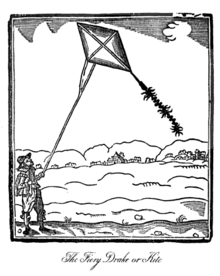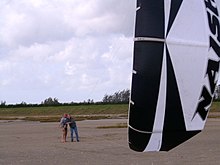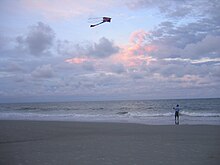This is an old revision of this page, as edited by 149.19.40.139 (talk) at 18:49, 6 October 2023 (→Cultural uses). The present address (URL) is a permanent link to this revision, which may differ significantly from the current revision.
Revision as of 18:49, 6 October 2023 by 149.19.40.139 (talk) (→Cultural uses)(diff) ← Previous revision | Latest revision (diff) | Newer revision → (diff) Tethered aircraft For other uses, see Kite (disambiguation).


A kite is a tethered heavier-than-air or lighter-than-air craft with wing surfaces that react against the air to create lift and drag forces. A kite consists of wings, tethers and anchors. Kites often have a bridle and tail to guide the face of the kite so the wind can lift it. Some kite designs do not need a bridle; box kites can have a single attachment point. A kite may have fixed or moving anchors that can balance the kite. The name is derived from the kite, the hovering bird of prey.
The lift that sustains the kite in flight is generated when air moves around the kite's surface, producing low pressure above and high pressure below the wings. The interaction with the wind also generates horizontal drag along the direction of the wind. The resultant force vector from the lift and drag force components is opposed by the tension of one or more of the lines or tethers to which the kite is attached. The anchor point of the kite line may be static or moving (e.g., the towing of a kite by a running person, boat, free-falling anchors as in paragliders and fugitive parakites or vehicle).
The same principles of fluid flow apply in liquids, so kites can be used in underwater currents. Paravanes and otter boards operate underwater on an analogous principle.
Man-lifting kites were made for reconnaissance, entertainment and during development of the first practical aircraft, the biplane.
Kites have a long and varied history and many different types are flown individually and at festivals worldwide. Kites may be flown for recreation, art or other practical uses. Sport kites can be flown in aerial ballet, sometimes as part of a competition. Power kites are multi-line steerable kites designed to generate large forces which can be used to power activities such as kite surfing, kite landboarding, kite buggying and snow kiting.
History

In China, the kite has been claimed as the invention of the 5th-century BC Chinese philosophers Mozi (also Mo Di, or Mo Ti) and Lu Ban (also Gongshu Ban, or Kungshu Phan). Materials ideal for kite building were readily available including silk fabric for sail material; fine, high-tensile-strength silk for flying line; and resilient bamboo for a strong, lightweight framework. By 549 AD, paper kites were certainly being flown, as it was recorded that in that year a paper kite was used as a message for a rescue mission. Ancient and medieval Chinese sources describe kites being used for measuring distances, testing the wind, lifting men, signaling, and communication for military operations. The earliest known Chinese kites were flat (not bowed) and often rectangular. Later, tailless kites incorporated a stabilizing bowline. Kites were decorated with mythological motifs and legendary figures; some were fitted with strings and whistles to make musical sounds while flying.

After its introduction into India, the kite further evolved into the fighter kite, known as the patang in India, where thousands are flown every year on festivals such as Makar Sankranti.
Kites were known throughout Polynesia, as far as New Zealand, with the assumption being that the knowledge diffused from China along with the people. Anthropomorphic kites made from cloth and wood were used in religious ceremonies to send prayers to the gods. Polynesian kite traditions are used by anthropologists to get an idea of early "primitive" Asian traditions that are believed to have at one time existed in Asia.
Kites were late to arrive in Europe, although windsock-like banners were known and used by the Romans. Stories of kites were first brought to Europe by Marco Polo towards the end of the 13th century, and kites were brought back by sailors from Japan and Malaysia in the 16th and 17th centuries. Konrad Kyeser described dragon kites in Bellifortis about 1400 AD. Although kites were initially regarded as mere curiosities, by the 18th and 19th centuries they were being used as vehicles for scientific research.

In 1752, Benjamin Franklin published an account of a kite experiment to prove that lightning was caused by electricity.
Kites were also instrumental in the research of the Wright brothers, and others, as they developed the first airplane in the late 1800s. Several different designs of man-lifting kites were developed. The period from 1860 to about 1910 became the European "golden age of kiting".
In the 20th century, many new kite designs are developed. These included Eddy's tailless diamond, the tetrahedral kite, the Rogallo wing, the sled kite, the parafoil, and power kites. Kites were used for scientific purposes, especially in meteorology, aeronautics, wireless communications and photography. The Rogallo wing was adapted for stunt kites and hang gliding and the parafoil was adapted for parachuting and paragliding.
The rapid development of mechanically powered aircraft diminished interest in kites. World War II saw a limited use of kites for military purposes (survival radio, Focke Achgelis Fa 330, military radio antenna kites).
Kites are now mostly used for recreation. Lightweight synthetic materials (ripstop nylon, plastic film, carbon fiber tube and rod) are used for kite making. Synthetic rope and cord (nylon, polyethylene, kevlar and dyneema) are used as bridle and kite line.
Materials

Designs often emulate flying insects, birds, and other beasts, both real and mythical. The finest Chinese kites are made from split bamboo (usually golden bamboo), covered with silk, and hand painted. On larger kites, clever hinges and latches allow the kite to be disassembled and compactly folded for storage or transport. Cheaper mass-produced kites are often made from printed polyester rather than silk.
Tails are used for some single-line kite designs to keep the kite's nose pointing into the wind. Spinners and spinsocks can be attached to the flying line for visual effect. There are rotating wind socks which spin like a turbine. On large display kites these tails, spinners and spinsocks can be 50 feet (15 m) long or more.
Modern aerobatic kites use two or four lines to allow fine control of the kite's angle to the wind. Traction kites may have an additional line to de-power the kite and quick-release mechanisms to disengage flyer and kite in an emergency.
Practical uses
Main article: Kite applicationsKites have been used for human flight, military applications, science and meteorology, photography, lifting radio antennas, generating power, aerodynamics experiments, and much more.
Military applications
Kites have been used for military purposes in the past, such as signaling, delivery of ammunition, and for observation, both by lifting an observer above the field of battle and by using kite aerial photography.
Kites were first used in warfare by the Chinese. During the Song dynasty the Fire Crow, a kite carrying incendiary powder, a fuse, and a burning stick of incense was developed as a weapon.
According to Samguk Sagi, in 647 Kim Yu-sin, a Korean general of Silla rallied his troops to defeat rebels by using flaming kites which also scared the enemy.
Russian chronicles mention Prince Oleg of Novgorod use of kites during the siege of Constantinople in 906: "and he crafted horses and men of paper, armed and gilded, and lifted them into the air over the city; the Greeks saw them and feared them".
Walter de Milemete's 1326 De nobilitatibus, sapientiis, et prudentiis regum treatise depicts a group of knights flying kite laden with a black-powder filled firebomb over the wall of city.
Kites were also used by Admiral Yi of the Joseon Dynasty (1392–1910) of Korea. During the Japanese invasions of Korea (1592–1598), Admiral Yi commanded his navy using kites. His kites had specific markings directing his fleet to perform various orders.

In the modern era the British Army used kites to haul human lookouts into the air for observation purposes, using the kites developed by Samuel Franklin Cody. Barrage kites were used to protect shipping during the Second World War. Kites were also used for anti-aircraft target practice. Kites and kytoons were used for lofting communications antenna. Submarines lofted observers in rotary kites.
Palestinians from the Gaza Strip have flown firebomb kites over the Israel–Gaza barrier, setting fires on the Israeli side of the border, hundreds of dunams of Israeli crop fields were burned by firebomb kites launched from Gaza, with an estimated economic loss of several millions of shekels.
Science and meteorology
Kites have been used for scientific purposes, such as Benjamin Franklin's famous experiment proving that lightning is electricity. Kites were the precursors to the traditional aircraft, and were instrumental in the development of early flying craft. Alexander Graham Bell experimented with very large man-lifting kites, as did the Wright brothers and Lawrence Hargrave. Kites had a historical role in lifting scientific instruments to measure atmospheric conditions for weather forecasting. Francis Ronalds and William Radcliffe Birt described a very stable kite at Kew Observatory as early as 1847 that was trialled for the purpose of supporting self-registering meteorological instruments at height.
Radio aerials and light beacons
Kites can be used for radio purposes, by kites carrying antennas for MF, LF or VLF-transmitters. This method was used for the reception station of the first transatlantic transmission by Marconi. Captive balloons may be more convenient for such experiments, because kite-carried antennas require a lot of wind, which may be not always possible with heavy equipment and a ground conductor. It must be taken into account during experiments, that a conductor carried by a kite can lead to high voltage toward ground, which can endanger people and equipment, if suitable precautions (grounding through resistors or a parallel resonant circuit tuned to transmission frequency) are not taken.
Kites can be used to carry light effects such as lightsticks or battery powered lights.
Kite traction

Kites can be used to pull people and vehicles downwind. Efficient foil-type kites such as power kites can also be used to sail upwind under the same principles as used by other sailing craft, provided that lateral forces on the ground or in the water are redirected as with the keels, center boards, wheels and ice blades of traditional sailing craft. In the last two decades several kite sailing sports have become popular, such as kite buggying, kite land boarding, kite boating and kite surfing. Snow kiting has also become popular in recent years.
Kite sailing opens several possibilities not available in traditional sailing:
- Wind speeds are greater at higher altitudes
- Kites may be maneuvered dynamically which increases the force available dramatically
- There is no need for mechanical structures to withstand bending forces; vehicles or hulls can be very light or dispensed with all together
Underwater kites
Underwater kites are now being developed to harvest renewable power from the flow of water.
- A kite was used in minesweeping operations from the First World War: this was a foil "attached to a sweep-wire submerging it to the requisite depth when it is towed over a minefield" (OED, 2021). See also paravane.
World records

There are many world records involving kites. The world's largest kites are inflatable single-line kites. The world record for the largest kite flown for at least 20 minutes is "The Flag of Kuwait".
The single-kite altitude record is held by a triangular-box delta kite. On 23 September 2014 a team led by Robert Moore, flew a 129 square feet (12 m) kite to 16,009 feet (4,880 m) above ground level. The record altitude was reached after eight series of attempts over a ten-year period from a remote location in western New South Wales, Australia. The 9.2 feet (3 m) tall and 19.6 feet (6 m) wide Dunton-Taylor delta kite's flight was controlled by a winch system using 40,682 feet (12,400 m) of ultra high strength Dyneema line. The flight took about eight hours from ground and return. The height was measured with on-board GPS telemetry transmitting positional data in real time to a ground-based computer and also back-up GPS data loggers for later analysis.
In popular culture
- The Kite Runner, a 2005 novel by Khaled Hosseini dramatizes the role of kite fighting in pre-war Kabul.
- The Peanuts cartoon character Charlie Brown was often depicted having flown his kite into a tree as a metaphor for life's adversities.
- "Let's Go Fly a Kite" is a song from the Mary Poppins film and musical.
- In the Disney animated film Mulan, kites are flown in the parade.
- In the film Shooter, a kite is used to show the wind direction and wind velocity.
- "Kite" is a 1978 song celebrating kite flying and appears on Kate Bush's first album, The Kick Inside.
General safety issues

There are safety issues involved in kite-flying. Kite lines can strike and tangle on electrical power lines, causing power blackouts and running the risk of electrocuting the kite flier. Wet kite lines or wire can act as a conductor for static electricity and lightning when the weather is stormy. Kites with large surface area or powerful lift can lift kite fliers off the ground or drag them into other objects. In urban areas there is usually a ceiling on how high a kite can be flown, to prevent the kite and line infringing on the airspace of helicopters and light aircraft. It is also possible for fighter kites to kill people, as happened in India when three spectators were killed in separate incidents during Independence Day, August, 2016—precipitating a ban on certain types of enhanced line.
The government of Egypt banned kite-flying in July 2020, seizing 369 kites in Cairo and 99 in Alexandria, citing both safety and national security concerns.
Designs
- Bermuda kite
- Bowed kite, e.g. Rokkaku
- Cellular or box kite
- Chapi-chapi
- Delta kite
- Foil, parafoil or bow kite
- Leading edge inflatable kite
- Malay kite see also wau bulan (Moon kite)
- Tetrahedral kite
- Sled kite
Gallery
-
This delta kite has a keel instead of a bridle
- Giant Japanese kite launched, 2019
-
Train of connected kites
-
 Kites fly on top of the Mitsui Store where the craftsmen are working on top of the roof, print by Hokusai
Kites fly on top of the Mitsui Store where the craftsmen are working on top of the roof, print by Hokusai
-
 Hiroshige II Enshū Akiha (1859)
Hiroshige II Enshū Akiha (1859)
-
 Illustration from the book Story of the mince pie by Josephine Scribner Gates, (1916)
Illustration from the book Story of the mince pie by Josephine Scribner Gates, (1916)
Types
Main article: Kite types- Fighter kite
- Indoor kite
- Inflatable single-line kite
- Kytoon - a hybrid tethered craft comprising both a lighter-than-air balloon as well as a kite lifting surface
- Man-lifting kite
- Rogallo parawing kite
- Stunt (sport) kite
- Water kite
See also
- Airborne wind turbine, concept for a wind generator flown as kite
- Captive helicopter
- Captive plane
- High altitude wind power
- Kite aerial photography
- Kite buggying
- Kite fishing
- Kite ice skating
- Kite landboarding
- Kite shape
- Kiteboating
- Kitelife, an American magazine devoted to kites
- Kitesurfing
- Kite rig
- List of kite festivals
- Sea Tails, video installation
- Solar balloon, a solar-heated hot air balloon that can be flown like a kite, but on windless days.
- Uttarayan, the kite flying festival of western India
- Weifang International Kite Festival
References
- Giant Kite Festival in HigashiomiNHK(video)
- Kytoon
- Eden, Maxwell (2002). The Magnificent Book of Kites: Explorations in Design, Construction, Enjoyment & Flight. New York: Sterling Publishing Company, Inc. p. 18. ISBN 9781402700941.
- "kite | Etymology, origin and meaning of kite by etymonline". Etymonline.com. Retrieved 14 December 2021.
- "Beginner's Guide to Aeronautics". NASA. Archived from the original on 2015-03-25. Retrieved 2012-10-03.
- "Flying High, Down Under". Archived from the original on 1 December 2008. Retrieved 14 December 2021.
- Woglom, Gilbert Totten (1896). Parakites: A treatise on the making and flying of tailless kites for scientific purposes and for recreation. Putnam. OCLC 2273288. OL 6980132M.
- "Science in the Field: Ben Balsley, CIRES Scientist in the Field Gathering atmospheric dynamics data using kites. Kites are anchored to boats on the Amazon River employed to sample levels of certain gases in the air". Archived from the original on 14 March 2008. Retrieved 14 December 2021.
- "The Bachstelze Article describes the Fa-330 Rotary Wing Kite towed by its mooring to the submarine. The kite was a man-lifter modeled after the autogyro principle". Uboat.net. Retrieved 2012-10-03.
- "Kite Fashions: Above, Below, Sideways. Expert kite fliers sometimes tie a flying kite to a tree to have the kite fly for days on end" (PDF). Archived from the original (PDF) on 23 July 2011. Retrieved 14 December 2021.
- "Underwater kiting". 2lo.de. Retrieved 2012-10-03.
- "Hydro kite angling device Jason C. Hubbart". Retrieved 2012-10-03.
- Needham (1965), Science and Civilisation in China, p. 576–580
- Sarak, Sim; Yarin, Cheang (2002). Khmer Kites. Cambodia: Ministry of Culture and Fine Arts. ASIN B005VDYAAW.
- Kite Flying for Fun and Science, 1907, The New York Times.
- Tripathi, Piyush Kumar (7 January 2012). "Kite fights to turn skies colourful on Makar Sankranti - Professional flyers to showcase flying skills; food lovers can relish delicacies at snack huts". The Telegraph. Calcutta, India. Archived from the original on August 13, 2013.
- Tarlton, John. "Ancient Maori Kites". Archived from the original on 15 October 2011. Retrieved 19 October 2011.
- Chadwick, Nora K. (July 1931). "The Kite: A Study in Polynesian Tradition". Journal of the Royal Anthropological Institute. 61: 455–491. doi:10.2307/2843932. ISSN 0307-3114. JSTOR 2843932.
- ^ Anon. "Kite History: A Simple History of Kiting". G-Kites. Archived from the original on 29 May 2010. Retrieved 20 June 2010.
- Needham (1965), Science and Civilisation in China, p. 580
- Ley, Willy (December 1962). "Dragons and Hot-Air Balloons". For Your Information. Galaxy Science Fiction. pp. 79–89.
- "Archived copy" (PDF). Archived from the original (PDF) on 2020-06-30. Retrieved 2018-06-12.
{{cite web}}: CS1 maint: archived copy as title (link) - "History of Kites". Archived from the original on 26 April 2012. Retrieved 18 April 2012.
- Military Aircraft, Origins to 1918: An Illustrated History of Their Impact, Justin D. Murphy, page 2
- "China Reconstructs". China Reconstructs. 15 December 1984. Retrieved 15 December 2021 – via Google Books.
- History of Science in Korea, Sang-un Chŏn, page 181
- "Kites- The History Attached With It". Sporteology. 2017-12-03. Retrieved 2019-02-01.
- Taking Flight: Inventing the Aerial Age, from Antiquity Through the First World War, Richard Hallion, pages 9-10
- "신호연신호 개요 (Summary of sending a signal with a kite)" (in Korean). Korea Culture & Contents Agency. Archived from the original on July 8, 2011. Retrieved July 30, 2009.
- M. Robinson. "Kites On The Winds of War". Members.bellatlantic.net. Archived from the original on 2012-01-21. Retrieved 2012-10-03.
- Saul, Trevor (August 2004). "Henry C Sauls Barrage Kite". Soul Search. Archived from the original on 2013-05-23. Retrieved 2012-10-03.
- Grahame, Arthur (May 1945). "Target Kite Imitates Plane's Flight". Popular Science. Retrieved 2012-10-03.
- "World Kite Museum". World Kite Museum. Archived from the original on 2009-04-06. Retrieved 2012-10-03.
- Focke Achgelis Fa 330
- Gazans Fly Firebombs Tied to Kites Into Israel, Sparking Several Blazes, Haaretz, 16 April 2018
- Gazans use kites to set fire to fields, forests in Israel, JNS, 17 April 2018
- Flaming kite from Gaza sets Israeli warehouse ablaze, Times of Israel, 21 April 2018
- Continuing kite threat puts Israeli farmers on edge, YNET, 24 April 2018
- Kite Terrorism: Compensation to Victims Archived 2018-05-02 at the Wayback Machine, Hadashot, 2 May 2018
- Ronalds, B.F. (2016). Sir Francis Ronalds: Father of the Electric Telegraph. London: Imperial College Press. ISBN 978-1-78326-917-4.
- Wales launches £25m underwater kite-turbine scheme The Guardian (retrieved 17 November 2015)
- Underwater Kites Can Harness Ocean Currents to Create Clean Energy Smithsonian.com (retrieved 17 November 2015)
- "Search Results". Guinness World Records. Retrieved 15 December 2021.
- "Largest kite flown". Guinnessworldrecords.com. 15 February 2005.
- "Highest altitude by a single kite". Guinness World Records. 23 September 2014. Retrieved 14 December 2021.
- Moore, R. "Untitled Page". Kitesite.com.au.
- "Egypt grounds kites for 'safety', 'national security'". news.yahoo.com. Retrieved July 12, 2020.
External links
- The earliest depiction of kite flying in European literature in a panorama of Ternate (Moluccas) 1600.
- Mathematics and aeronautical principles of kites.
- Kitecraft and Kite Tournaments (1914)—A free public domain e-book
- Trivedi, Parthsarathi; et al. "Aerodynamics of Kites" (PDF). Archived from the original (PDF) on 12 June 2013. Retrieved 8 February 2013.
- Eyes on Brazil
| Application of wind energy | |
|---|---|
| Wind power | |
| Vehicle propulsion | |
| Kite applications | |
| Air current | |
| Types of aircraft by methods of thrust and lift | |||||||||||||||||||||||||
|---|---|---|---|---|---|---|---|---|---|---|---|---|---|---|---|---|---|---|---|---|---|---|---|---|---|
| |||||||||||||||||||||||||
| |||||||||||||||||||||||||
| Kites and kite flying | ||
|---|---|---|
| Types by use |  | |
| Types by shape | ||
| Activities and applications | ||
| Parts | ||
| People | ||
| Other | ||